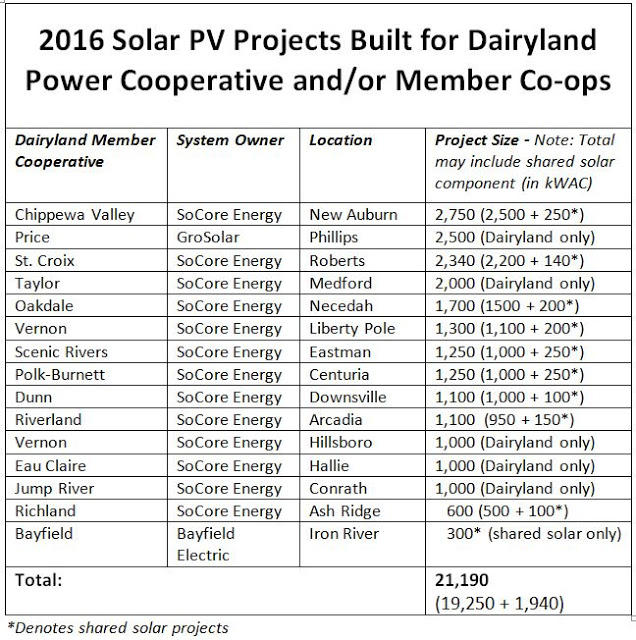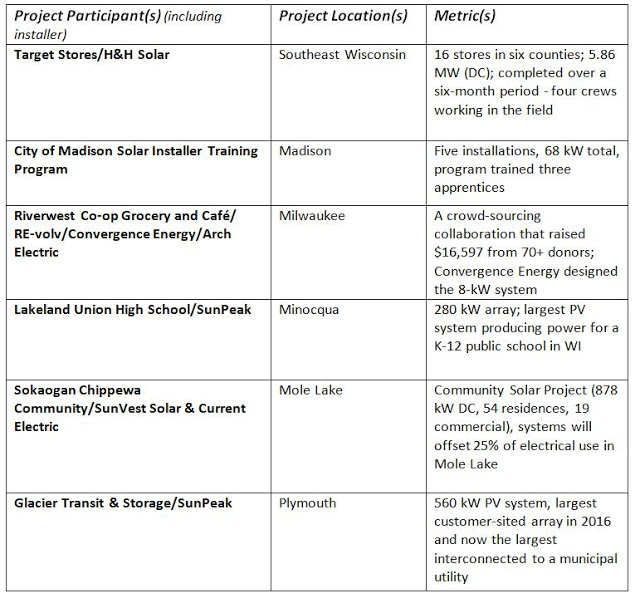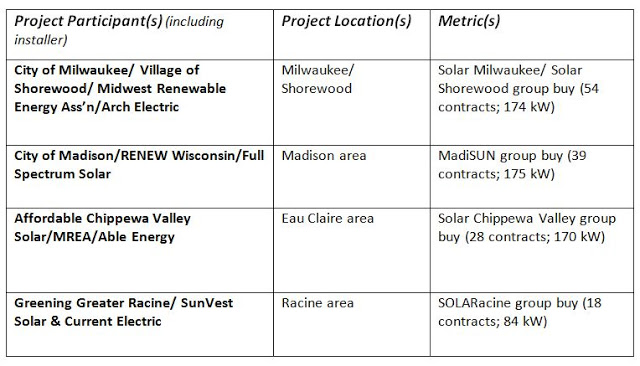FOR IMMEDIATE RELEASE
January 16, 2017
More information
Tyler Huebner, Executive Director
608.255.4044 x 1
tyler.huebner@renewwisconsin.org
The biggest and best renewable electric installations in 2016 are set to be recognized at RENEW Wisconsin’s annual Renewable Energy Summit this Thursday, January 19th in Madison. The recognition ceremony will take place at 12:45 PM, during lunch. The Summit will be held at the Monona Terrace in Madison; registration starts at 8:00 AM and the program runs from 9:00 AM to 3:30 PM.
As strong a year as 2015 was for Wisconsin solar installers, 2016 shattered records for total capacity added, with several electric providers, led by La Crosse-based Dairyland Power Cooperative and many of its member cooperatives, generating most of the momentum. Between utility-scale projects on the one end to residential rooftop installations on the other, Wisconsin’s solar output will more than double the previous year’s totals.
Indeed, since last year’s Summit, construction started on more than 30 megawatts of solar panel installations, which will generate enough electricity to supply about 5,000 Wisconsin homes’ annual electricity usage.
The recognition will be bestowed across three categories:
Utility solar. In 2016 Dairyland Power Cooperative entered into contracts to purchase the output from 14 solar arrays under construction in Wisconsin, with a combined capacity of nearly 19 megawatts. On top of the capacity serving Dairyland, many member cooperatives agreed to additional panels to supply their shared solar programs. All told, Wisconsin’s electric cooperatives committed to more than 21 megawatts of solar last year.
Two Madison-based investor-owned utilities, Alliant Energy and Madison Gas & Electric, brought three arrays online in 2016. When it was energized, Alliant’s solar array in the Town of Beloit became the largest solar-powered generator in Wisconsin. Madison Gas & Electric’s shared solar project came about through an innovative partnership with the City of Middleton, whose rooftops now holds more than 600 kW of solar, as the City police station added an array in addition to the larger MG&E Shared Solar project.
Landmark and innovative initiatives. National corporations, state-based businesses, Wisconsin communities, and local activists continued their progress in embracing solar energy to advance public policy goals and/or enhance their business profile. In 2016, several noteworthy initiatives and collaborations were launched that married clean electricity productions with other objectives such as economic competitiveness, job training, and community-building.
Residential solar group purchase programs. Cities and nonprofit organizations collaborated to launch four community-based solar group purchase programs, spanning from Eau Claire in the northwest to Racine in the southeast. Solar group purchase programs are designed to reduce the cost and complexity of installing solar panels on individual houses, while sharing the benefits of increased marketing and community involvement. By the end of 2016, these four programs resulted in 139 households committing to install more than 600 kW of solar on their properties, far outpacing previous years’ totals.
“Wisconsin solar energy saw its best year ever in 2016, with the projects installed and under construction more than doubling the state’s total production,” said Tyler Huebner, RENEW Wisconsin’s Executive Director. “But we can’t stop here, because our neighboring states are growing even faster than us. In 2017, we will also see the welcome development of wind energy and biogas investments come back to Wisconsin. Increasing our renewable energy investments and usage will help build a stronger, cleaner economy for Wisconsin.”
For more information on the 2017 Summit program agenda, speakers, and registration, please visit http://www.renewwisconsin.org/2017_Summit/.




